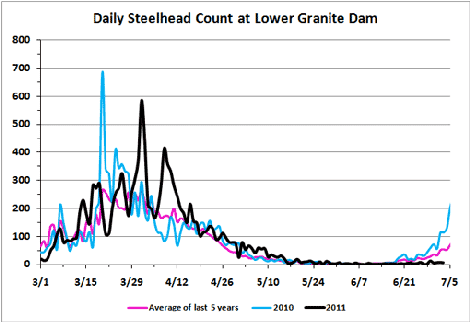forum
library
tutorial
contact

Steelhead Entering Idaho
by Eric BarkerSpokesman-Review, July 11, 2011
|
the film forum library tutorial contact |

|
Steelhead Entering Idahoby Eric BarkerSpokesman-Review, July 11, 2011 |
Better late than never, Clearwater anglers say
 Steelhead are making their way up the Snake River, a bit later than last year.
Steelhead are making their way up the Snake River, a bit later than last year.
A few anglers have started to fish for the sea-run trout in Idaho's Clearwater River, which opened for catch-and-release fishing July 1.
Bass anglers have turned up a few steelhead in the Grande Ronde River.
They can expect an overall return that is pretty similar to recent steelhead runs:
About 120,500 of those will be wild fish that are protected by the Endangered Species Act and can't be kept by anglers. The B-run is expected to number 54,100 at Bonneville and include about 12,900 protected wild fish.
From 2000 to 2009, the average return to Bonneville was 315,600 A-run steelhead, including 85,100 wild fish, and 64,400 B-run steelhead, including 12,800 wild fish. In 2010, 381,100 upriver steelhead returned to Bonneville Dam, including 304,000 A-run fish and 77,100 Bs.
Idaho Department of Fish and Game fisheries biologist Alan Byrne said about 50 percent of the smaller A-run steelhead counted at Bonneville Dam will pass Lower Granite Dam and about 70 to 75 percent of the larger B-run fish will make it from Bonneville to Granite.
That means anglers can expect 156,000 A-run fish to make it at least as far as Granite and 37,800 to 40,000 B-runs to return to the Clearwater and Salmon river basins. The A-run has a smaller conversion rate because those counted at Bonneville are destined for rivers all over the Columbia Basin, where as the bigger fish are mostly bound for tributaries of the Snake River in Idaho.
As of Thursday, more than 1,100 steelhead had been counted at Lower Granite Dam since June 1. The 10-year average is 2,441.
During most years, early-returning A-run steelhead pull into the lower Clearwater River to escape warmer water in the Snake River. This week, the lower Clearwater was 57 degrees and the Snake River at Anatone was about 65 degrees.
Steelhead were climbing over Lower Granite at a rate of more than 100 a day. (See "fish counts" for Snake and Columbia dams in the S-R Sports section.)
Each summer, water is released from Dworshak Reservoir to cool the lower Snake River and increase flows to help migrating juvenile fall chinook. Those drawdowns have begun.
The Army Corps of Engineers expects the dam to release about 14,000 cfs through August, bringing the reservoir 60 feet below full pool. It will be lowered an additional 20 feet in September.
learn more on topics covered in the film
see the video
read the script
learn the songs
discussion forum
